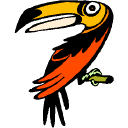
Costa Rica
December 26, 2000 to January 11, 2001

 |
Costa RicaDecember 26, 2000 to January 11, 2001 |
 |
|
We recently returned from a two and a half week trip to Costa Rica. No doubt you have heard that the place is an ecological paradise. So I will just tell you what we saw: Crocodiles and Caiman, Multi-colored lizards (including the Jesus Christ lizard, which actually runs on water), Iguanas, and other prehistoric looking creatures; sloths slothing; zillions of birds, including Pelicans, Toucans and a rare, early Quetzal, and hundreds of species of Hummingbirds; monkeys (Howler, Spider, and White Faced); land crabs; Agouti; colorful frogs; insects both beautiful and ugly, including a walking stick, leaf cutters, and stinging ants (ouch!); an Olingo (a raccoon like creature acting like a monkey in a tree); varieties of tarantulas and other multicolored spiders, and thousands of species of spectacular butterflies. The tropical forests were beautiful, and the beaches were nice, and the prices were about two thirds what you would expect to pay in the U.S. The country is still unspoiled. So go already, before they make the place into another Hawaii. Here are some things that surprised us, and some pieces of advice:
|
||
 Surprises
and advice: Always hire a guide to tour a jungle or rainforest. Animals are masters of disguise and deception. You will walk by 90% of them without being aware of their presence unless you are with a guide who knows how to find them by knowing habitat, sounds, and smells. Good guides will also fully explain the plant and animal ecology you are looking at, and will convince you that it is very fragile. It is fascinating. Guides are not expensive. For example, three of us hired an English speaking biologist in the Santa Elena Reserve (near Monte Verde) for $15 per person for three and a half hours. Surprises
and advice: Always hire a guide to tour a jungle or rainforest. Animals are masters of disguise and deception. You will walk by 90% of them without being aware of their presence unless you are with a guide who knows how to find them by knowing habitat, sounds, and smells. Good guides will also fully explain the plant and animal ecology you are looking at, and will convince you that it is very fragile. It is fascinating. Guides are not expensive. For example, three of us hired an English speaking biologist in the Santa Elena Reserve (near Monte Verde) for $15 per person for three and a half hours.
Bring binoculars, or miss half of what there is to see. I saw a grand total of three mosquitoes in two and a half weeks, much of which was spent in rain forests and jungles. Only one of them bit me. We were told that only sometimes are the mosquitoes bad. The temperature was mostly comfortable. We had only a few hot afternoons, and the nights were comfortable enough for sleeping without air conditioning. We needed only lightweight clothing for most days, a jacket for the nights in the mountains, and of course, rain gear. (The forests are rain forests, of course.) It gets light about 6am, and dark about 6pm, plus or minus half an hour, year round. The best wildlife is found just after dawn and just before and during dusk. Plan accordingly. Although the towns seemed somewhat run down and poor, there was no one begging for money, no little kids trying to shine my shoes, and no aggressive street salesmen trying to sell me souviniers. The people were wonderful to us. About half of those we encountered spoke English. But with my very poor Spanish, sign language, drawing pictures, and writing out numbers, we managed just fine. We had reserved all lodging and some tours on-line in English in advance. Consequently we were certain that we could communicate with at least one person wherever we went. Always ask you local host where the best restaurants are. You will never find them on your own. We were sent to one place in Playa Domincalita that had a spectacular ocean view on two sides and served wonderful sea food, but which was at the end of a mile long dirt road with almost no markings on it saying that it goes to a restaurant. Similarly, the best restaurants in the Monte Verde area are on dirt roads you would never think of driving unless you were given directions. Our lodging hosts always sent us to great restaurants. E-mail to and from Costa Rica is very slow and unreliable. On separate occasions both one of our hotels and our car rental agency lost e-mail capability for about a week while we were negotiating reservations. It can take a day just to get delivery of a message under normal circumstances. This is all because of poor telephone infrastructure plus a monopoly on Internet services in the country. Internet cafes are cheap, but very, very slow. Don’t count on using them. An excellent quick-read write-up on the basics of Costa Rica can be found at 1000 Tips4Trips.
|
||
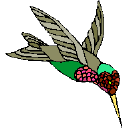 Money:
About
half the time prices are quoted in dollars, and the other half in Colones.
Bring lots of $1 and $5 bills. Change is rarely made in dollars,
so you get your change in Colones at whatever exchange rate the merchant
wants to give you. Money:
About
half the time prices are quoted in dollars, and the other half in Colones.
Bring lots of $1 and $5 bills. Change is rarely made in dollars,
so you get your change in Colones at whatever exchange rate the merchant
wants to give you.
We found the best exchange rates at two of our hotels, which gave us the interbank rate without commission (names below). We never used a bank or an ATM. The second best rate came from using my VISA debit card from CompuBank, which does not add on the usual 3% fee other banks charge, leaving the exchange with only the 1% fee VISA charges. Often, but not always, there is an 8-10% fee for using a credit card. Ask. Sometimes there is a fee for travelers check use. Ask. U.S. dollars were widely accepted, but not always. Grocery stores, taxies, and busses required Colones, for example. Many telephones do not accept coins. For emergencies, always carry a phone card, which can be purchased at the local telephone office (and nowhere else that we could find.) If you are crossing into Nicaragua, perhaps by boat in order to get into one of the Costa Rican lodges, you must pay $5 US per person. Costa Rican Colones are absolutely not accepted. Change may not be available. Plan ahead.
|
||
 Lodgings:
Most lodgings provide exactly one source of hot water: the shower.
(One expensive lodge didn’t even provide that. Ask.) If you
need hot water out of the tap in the bathroom, be prepared to pay double
or triple the price. The hot water for the showers is heated electrically
at the showerhead. This takes some getting used to. There is
only one handle to control the shower. First turn on the lights in
the bathroom. Then turn the shower handle on very slowly, until the
lights dim. Then you know the water heater is on. Let the water
run slowly for about three minutes to let the coils heat up. You
should get a low flow of hot water. Then when you turn up the volume
of water, you are simply adding cold water to the flow. More flow,
colder water. Your choice. Lodgings:
Most lodgings provide exactly one source of hot water: the shower.
(One expensive lodge didn’t even provide that. Ask.) If you
need hot water out of the tap in the bathroom, be prepared to pay double
or triple the price. The hot water for the showers is heated electrically
at the showerhead. This takes some getting used to. There is
only one handle to control the shower. First turn on the lights in
the bathroom. Then turn the shower handle on very slowly, until the
lights dim. Then you know the water heater is on. Let the water
run slowly for about three minutes to let the coils heat up. You
should get a low flow of hot water. Then when you turn up the volume
of water, you are simply adding cold water to the flow. More flow,
colder water. Your choice.
It is really true that you must not put toilet paper in the toilet. Put it in the wastebasket provided. Yes, this is gross, but not as gross as an overflowing toilet. The only exceptions to this might be found in the most modern and expensive, but even in these the rule might still be true. Ask. You will never offend by doing so. Some of the hotels and lodges have hard tile floors. When wet they are very slippery. My companion discovered the hard way (pardon the pun) that when dry they can also be very slippery, especially when wearing acrylic socks and no shoes. Beware, and be careful. Always ask if it is ok to store food in your room. Once when we didn’t ask, we found our food covered by a zillion stinging ants. Our hands were quite painful for hours. A wonderful list of a large number of hotels by region and price (down to under $15) can be found at http://www.westnet.com/costarica/Hotelreg.html. Sometimes a link to the hotel’s web site is included, but more often than not the hotel has a web site that is not listed here. Use your favorite search engine. We had great difficulty finding lodging in the Jaco Beach area for New
Year’s Eve. So we contacted Costa
Rica's Travel Web at http://www.crica.com.
They have complete knowledge of all lodgings in Costa Rica and will book
you into any of them. They were able to find us what we needed at
a cost only slightly higher than we wanted to pay. I think they charged
a 5% fee. Worth it if you need it.
|
||
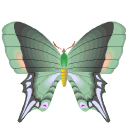 Driving:
Renting a car is very expensive. This is mainly because you must
pay for liability insurance, and by law you may not waive collision insurance,
even if your credit card covers it. Rental car rates may or may not
include this insurance, plus taxes and second driver fee. Always
be sure to insist that your quote includes these items before you commit
to a company. Driving:
Renting a car is very expensive. This is mainly because you must
pay for liability insurance, and by law you may not waive collision insurance,
even if your credit card covers it. Rental car rates may or may not
include this insurance, plus taxes and second driver fee. Always
be sure to insist that your quote includes these items before you commit
to a company.
Contrary to what all the official tourist sites tell you, 4-wheel drive is not necessary in the dry season. We drove many dirt roads, including the ones to Monte Verde, in a two-wheel drive Toyota rental car. No sweat. Just drive slowly, and steer around the bumps. This information could save you a lot of money on your rental car. We found out about it by asking the proprietors of every lodging at which we planned to stay if 4-wheel drive was really necessary to get to their place on the dates we planned to arrive. All told us no. I highly recommend Mapache Rent a Car (http://www.mapache.com/). They had the best price and quoted the full price up front, gave us a 2001 Toyota, delivered it to our hotel and retrieved it from there, and took great care that we understood all aspects of the rental. For some reason this company’s web site did not show up on the search engines I used. It was recommended by Hotel Apart-Roma, about which I will have more to say below. Except for the few main highways, the potholes are horrendous. Grates covering storm drains at street corners are often missing, exposing both cars and pedestrians to four foot deep drops. Be careful. Never, never leave anything in an unattended car, not even for a few minutes. The rate of violence in Costa Rica is very low (except perhaps in parts of San Jose), but the rate of theft is very high. So protect your stuff. The grating you see on all of the houses is not there just for decoration. The locals universally agree that the police are quite incompetent at solving crimes against property. They are very good at setting up radar speed traps, however. We saw one every 30 miles or so on the main highways If they have muffler and air pollution laws in Costa Rica, they are not enforced. Bring earplugs, and be sure your rental car has the means of closing outside air vents for when you are stuck behind a bus or truck spewing exhaust. You could be stuck for 20 minutes or so. There are few turnouts on Costa Rica highways. When you estimate your driving time from a map, double it or triple it. You are guaranteed to be stuck behind a slow truck or a bus that stops every half mile. There are few turnouts, so you may not be able to pass for 20 minutes. The best map was the one we got from our rental car agency. The
second best was the one published by costaricamap.com. You can buy
it from them for a $5 shipping fee (http://www.costaricamap.com/ing/freemap.html).
But we got it for free, I think from the Costa Rica Tourist Board: 800-343-6332.
The maps are contradictory, but between them they are at least 95% right.
(This is why we always carry a compass.) Locals are always willing
to give directions, but often only in Spanish. The map we bought
in the U.S. published by International Travel Maps was completely useless.
|
||
 Locations: Locations:
San Jose area: . We were told by many
to avoid San Jose due to possible violent robbery. So we stayed in
Heredia, a university town 12 km north of San Jose, and a $10 cab ride
from the airport at night (2000 Colones return in the day – less than $7).
If you must go to San Jose, a cab costs $7-8, and a bus cost less than
a dollar.
The hotel is located up a steep hill about a 10 minute walk (or a very cheap cab or bus ride) from the commercial area of Heredia and the university. It has only two problems. The street is very noisy with traffic (remember – no muffler law). When we mentioned this to Nidia, she put us in an apartment that had a bedroom separated from the street by two walls. Problem solved. Parking seems to be on the street only. (I may be wrong – ask about safe parking if you need it.) This did not concern us, since our rental car was delivered to us the morning we left the hotel, and was picked up from the hotel when we returned the night before our departure from the country. I highly recommend the restaurant Spoons in Heredia.
If you have a few hours to kill, I highly recommend Zoo
Ave in Alajuela, outside of San Jose. This is a small zoo with
a wonderful display of birds, monkeys, and a few other animals, in a beautiful
tropical forest environment. Most of the animals are allowed enough
space to be able to at least pretend they are in the wild. The monkeys
are not caged at all. Two hundred species of birds migrate to this
location and so live outside the confinements. Bring your binoculars.
Allow 1½ hours to see the place. It’s 15 minutes to half an
hour from the airport, depending on whether you or your taxi driver knows
where it is. A more complete description of the place can be found
at http://www.worldheadquarters.com/cr/zoo_ave/
|
||
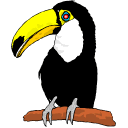 Monte
Verde area:. There are two main reserves in the area, Santa
Elena, and Monte Verde. They have similar ecosystems. Santa
Elena Reserve is the less visited (limited to 100 people a day, I think),
and so is much quieter, which is essential for viewing wildlife.
I recommend that you get Jacques, who runs the Pension Santa Elena and
its information center described below (call him Jack), to hire you a guide
for 6:30am. That way you will be assured of getting into the place,
and will be there at a time when the animals are most active. Jacques
has a long list of guides he will never hire again, and a shorter list
of those he will. So do make use of his experience. Our guide
was Maria. There is nothing she doesn’t know about the Santa Elena
Reserve. She has a degree in biology, and will show you in great
detail how the plants and animals are interdependent, and how fragile this
ecosystem is. I recommend you ask for her. Monte
Verde area:. There are two main reserves in the area, Santa
Elena, and Monte Verde. They have similar ecosystems. Santa
Elena Reserve is the less visited (limited to 100 people a day, I think),
and so is much quieter, which is essential for viewing wildlife.
I recommend that you get Jacques, who runs the Pension Santa Elena and
its information center described below (call him Jack), to hire you a guide
for 6:30am. That way you will be assured of getting into the place,
and will be there at a time when the animals are most active. Jacques
has a long list of guides he will never hire again, and a shorter list
of those he will. So do make use of his experience. Our guide
was Maria. There is nothing she doesn’t know about the Santa Elena
Reserve. She has a degree in biology, and will show you in great
detail how the plants and animals are interdependent, and how fragile this
ecosystem is. I recommend you ask for her.
Also near Santa Elena don’t miss the Butterfly Farm. You get an
entertaining and fascinating tour of bugs and butterflies, and will know
most of what there is to know about them when you are finished.
There are two canopy tours leaving from the same place on the road to the Santa Elena Reserve. One, called the Sky Trek, is expensive, uses many cables, and is mainly an adventure activity. The other, called Sky walk, is less expensive, and is a system of trails and suspension bridges that allows you to walk through and view what goes on in the canopy of the forest. I highly recommend the latter. On the road from Santa Elena to the Monte Verde Reserve there are a number of art galleries. Be sure to stop at all of them. They have wonderful artwork by local artisans. The woodwork is especially well done. Bring money. The small community of Santa Elena had all the services we needed. There is a grocery store, a bakery, a bank, a post office, many restaurants to meet anyone’s tastes and budget, and a wide range of lodging. There is bus service to San Jose. We stayed in a wonderful room in Pension
Santa Elena in the town of Santa Elena. It was the best room
in the place, and cost us only $35, private bath and kitchen privileges
included. You can see a picture of the room by using the link above(it’s
the room at the top right). This place is a pension and a hostel.
You can get a bed for $5 or a room with or without bath for more.
It is clean and well run. However, the walls are thin, and if you
are in the building with the kitchen, you won’t sleep while it is open.
Our room was the only one that does not share a wall with another, and
it is in a separate building from the kitchen and hostel central area.
Jacques Bertrand, the owner, is a fountain of information about the area.
He runs an official information site for the area, so be sure to speak
with him even if you don’t stay at his place. He helped arrange our
tickets for the Sky Walk, Eco-Farm and Butterfly Farm mentioned earlier.
This pension gave us the interbank exchange rate for whatever local currency
we needed.
|
||
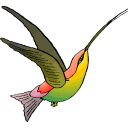 Western
Costa Rica (Central and South): We walked out onto the highway
bridge just north of Carara Reserve, which is just north of Jaco Beach.
In the river below were at least 30 huge Crocodiles. Very impressive.
The reserve itself is quite nice, and is reputed to be full of animals.
We saw only a few, probably because we were unable to hire a guide, because
we were here on New Year's day. We were told that guides are usually
available for hire at the entrance. The reserve spans several types
of eco-systems. Western
Costa Rica (Central and South): We walked out onto the highway
bridge just north of Carara Reserve, which is just north of Jaco Beach.
In the river below were at least 30 huge Crocodiles. Very impressive.
The reserve itself is quite nice, and is reputed to be full of animals.
We saw only a few, probably because we were unable to hire a guide, because
we were here on New Year's day. We were told that guides are usually
available for hire at the entrance. The reserve spans several types
of eco-systems.
We spent several days at the Sabalo Lodge on the Oso peninsula (http://www.sabalolodge.com/). You get there by boat from Sierpe through a maze of jungle waterways. It was a very relaxing experience. A maximum of six couples are permitted to visit at one time. The pace is slow, the food is wonderful, and the proprietors are most hospitable. The lodge is solar powered, has a tile floored porch surrounding it from which you can view monkeys and birds. A stream runs through the property, good for swimming. I spent a lot of time sitting by that stream, reading a book, and watching for animals. Activities are described on the web site. There are only two problems with this place. First, the showers (in the shared bathhouse) are cold water only. So call them refreshing. Second, the tides dictate when you arrive and leave. High tide is required. Our options for departure time from Sierpe were 5am or 5pm. If you take a boat tour from the lodge, plan to return within an hour, or plan to be dropped off on a deserted beach for the day, being picked up 10 or 12 hours later. Also, I recommend that you specifically request that life jackets be in the boat that picks you up. Apparently they aren’t required in Costa Rica, but will cheerfully be provided if you request them in advance. The mountain drive on highway 16 from Neily to San Vito (especially),
and also from there to San Isidro and then down to Playa Dominical is quite
beautiful. On that route, the Wilson Botanical Gardens are reputed
to be spectacular. But since we were told that it takes four hours
to tour them, we did not have time to do so.
|
||
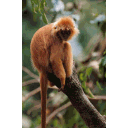 Northeast
Costa Rica: We stayed at the Samay
Lagoon Lodge in the Barra del Colorado near Tortuguero (http://www.samay.com/index1.htm).
This is a wonderful old lodge located in a jungle setting with the Río
Colorado on one side, the Caribbean waterfront on the other, and Samay
Lagoon across the way. The nature program consists of a combination
of three canoeing and hiking trips (one at night!) led by Carlos, an amazing
guide who can find all kinds of animals you would never know were there
without him. The setting is absolutely perfect. The best of
the three trips was a canoe trip up a very narrow jungle stream that opens
into a beautiful lagoon called Laguna Nueve. Northeast
Costa Rica: We stayed at the Samay
Lagoon Lodge in the Barra del Colorado near Tortuguero (http://www.samay.com/index1.htm).
This is a wonderful old lodge located in a jungle setting with the Río
Colorado on one side, the Caribbean waterfront on the other, and Samay
Lagoon across the way. The nature program consists of a combination
of three canoeing and hiking trips (one at night!) led by Carlos, an amazing
guide who can find all kinds of animals you would never know were there
without him. The setting is absolutely perfect. The best of
the three trips was a canoe trip up a very narrow jungle stream that opens
into a beautiful lagoon called Laguna Nueve.
Alas, the place has management problems. The brochure promises English speaking guides (plural). In fact, two couples staying at the place with us specifically asked if the guide for their nature program speaks English, and were specifically told by Thomas Scheytt at their office that he did. Well, Grethel, the manager of the lodge, told us that the only nature guide that has ever worked there in the last six years is Carlos. Carlos speaks no English. This poses somewhat of a problem for people who do not speak Spanish, as they will not be able to understand what Carlos is trying to point out, or even where it is, and would not be able to understand safety instructions. We booked the place for two full days of activities at the lodge. Before doing so, I specifically asked by e-mail “If we were to stay two days, what would we do the second day? Are there more boat or walking tours of the area than are offered that first day?” The response from Thomas Scheytt was “We will do additional tours on additional days, either canoeing or boat tours in the Refugio National and the canals. We will keep you busy. There is a lot to see.” Upon arrival Grethel told me that Carlos had available only the three tours we would get the first day, and the second day would be a repeat of the first. I did not have enough Spanish to ask Carlos if this was true. We left a day early. We had to ask for life jackets for the canoe trips. Grethel provided them with a patronizing, condescending attitude, telling us that the canoes wouldn’t tip over. They didn’t, but if they had, they would have sunk (no flotation tanks). I asked Carlos how many people would be the maximum number he could take on a tour and still be able to show animals to all of them. He said five. This seemed about right to me, since this would be two canoes of three people each, including Carlos. Later I asked Grethel how many people the lodge could handle at one time. She said 60. She said she had 12 coming in the day we were to leave. I asked if they were all going on Carlo’s tour. She said yes and volunteered without my asking that most of the people would see no animals because the group would be too large. She did not seem at all perturbed by this. We were transported to the lodge in a covered boat (the one shown on their web site). We were returned in an open boat. It was raining. That was two and three quarters hours of freezing, wet misery. When we arrived at the harbor, we noticed that all of the other boats were covered. Then the person employed by the lodge who met us there expressed surprise that Grethel didn’t have the cover installed on our boat. There was a cover?!! I have no idea why we were treated so poorly by Grethel. I would recommend this place only under certain conditions. You
must understand enough Spanish to be able to follow the directions of Carlos
the guide. You should reserve only a day in advance after first ascertaining
that there will be no more that a total of five people doing the eco-tour,
and hope that the answer is honest (preferably someone other than Thomas
Scheytt). Or, perhaps you should inquire if other nearby lodges have
a similar program. Ask if they do a night exploration, if they use
canoes, and if they will take you to “Laguna Nueve” or a similar place.
|
||
 Airlines:
We flew to Costa Rica via American Airlines and Lacsa Airline, a member
of Grupo Taca. We returned via Lacsa. Lacsa is mostly a wonderful
airline that has the feel of the airlines thirty years ago, except that
their fleet is very modern. The price is usually about $100 less
than that of U.S. airlines. There is extra legroom in cattle class.
The employees are all upbeat, with a can-do attitude. When a bunch
of luggage didn’t make a transfer in San Salvador (so what airline doesn’t
do that occasionally?), we did not have to trek around the San Francisco
airport looking for their baggage department. Instead, an army of
employees set up a station right at the luggage claim area to take our
claims. (The luggage was delivered to my home the next day.)
My only complaint is that the seat I had from San Salvador to San Francisco
was the most uncomfortable seat I have ever flown in in 35 years of flying.
Of course, a Continental Airlines seat a few years ago ran a close second,
and all other legs of my Lacsa flight were most comfortable. You
can’t book on line, and their web site is almost useless, so the best way
to contact them is by phone at (800) 225-2272. Airlines:
We flew to Costa Rica via American Airlines and Lacsa Airline, a member
of Grupo Taca. We returned via Lacsa. Lacsa is mostly a wonderful
airline that has the feel of the airlines thirty years ago, except that
their fleet is very modern. The price is usually about $100 less
than that of U.S. airlines. There is extra legroom in cattle class.
The employees are all upbeat, with a can-do attitude. When a bunch
of luggage didn’t make a transfer in San Salvador (so what airline doesn’t
do that occasionally?), we did not have to trek around the San Francisco
airport looking for their baggage department. Instead, an army of
employees set up a station right at the luggage claim area to take our
claims. (The luggage was delivered to my home the next day.)
My only complaint is that the seat I had from San Salvador to San Francisco
was the most uncomfortable seat I have ever flown in in 35 years of flying.
Of course, a Continental Airlines seat a few years ago ran a close second,
and all other legs of my Lacsa flight were most comfortable. You
can’t book on line, and their web site is almost useless, so the best way
to contact them is by phone at (800) 225-2272. | ||
 Bottom line: Go! |